Joint Resource and Trajectory Optimization for Energy Efficiency Maximization in UAV-Based Networks
Abstract
1. Introduction
- We propose a UAV-based network where orthogonal frequency-division multiplexing (OFDM) is adopted for UAV gathering information. We aim to maximize EE, and the optimization problems of time slot assignment, UAV trajectory, and power allocation are decomposed into three parts to solve.
- First, the UAV optimization problem is formulated to maximize the uplink throughput of UAV-served users, with the flight trajectory of the UAV also considered. The Taylor theory we have put forward for this problem turns the non-convex problem into an approximated problem that becomes a convex problem.
- Second, the power allocation is one of the decisive factors for increasing EE. The Dinkelbach method is considered as an efficient algorithm in the infraction form problem to convert to a non-infraction form.
- Third, the system schedule of the number of time slots to allocate N users. We construct the price matrix in case the number of users is smaller than the number of time slots. Therefore, the Hungarian algorithm can be applied to obtain the optimal solution for the assignment problem.
- Finally, we show that the EE applied to our alternating optimization algorithm has been significantly improved compared to other algorithms. The flight trajectory of the UAV also shows us that it tends to always focus on serving ground user best.
2. System Model and Problem Formulation
2.1. System Model
2.2. Problem Formulation
3. Solution Approach
- 1
- Solving the UAV trajectory while fixing the power allocation and the time slot assignment of all users.
- 2
- Solving the power allocation while fixing the UAV trajectory and the time slot assignment of all users.
- 3
- Solving the time slot assignment while fixing the power allocation of all users and the UAV trajectory.
3.1. UAV Trajectory Optimization
3.2. Power Allocation
| Algorithm 1: Power allocation based on the Dinkelbach method. |
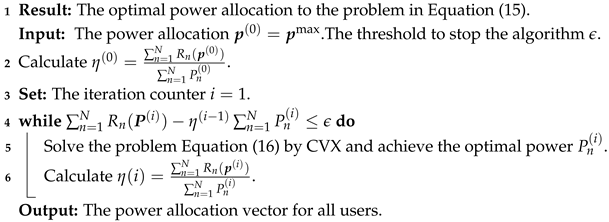 |
3.3. Time Slot Assignment
| Algorithm 2: Hungarian time slot assignment algorithm. |
 |
3.4. Alternating Optimization Algorithm
| Algorithm 3: Alternating algorithm. |
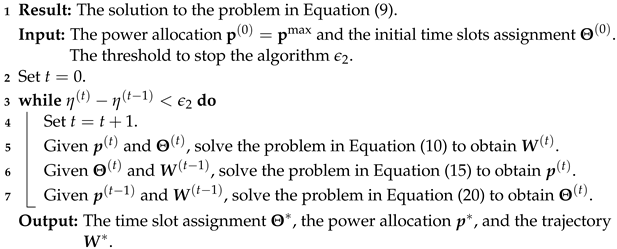 |
4. Simulation Results and Discussion
- (1)
- The circular trajectory is used to compare with the proposed trajectory optimization.
- (2)
- The maximum power will be set to all users to compare with the proposed power allocation.
- (3)
- Finally, the fairness time slot allocation will be used to replace the Hungarian with the allocation time slot for all users, in which the system will divide the time slots resource evenly to all users.
5. Conclusions
Author Contributions
Funding
Institutional Review Board Statement
Informed Consent Statement
Data Availability Statement
Conflicts of Interest
References
- Nokia Drone Networks Solution for Public Safety and Industries. Available online: https://www.dac.nokia.com/applications/nokia-drone-networks/#use-cases (accessed on 10 October 2022).
- How Amazon is Building Its Drone Delivery System. Available online: https://www.aboutamazon.com/news/transportation/how-amazon-is-building-its-drone-delivery-system (accessed on 10 October 2022).
- Merwaday, A.; Tuncer, A.; Kumbhar, A.; Guvenc, I. Improved Throughput Coverage in Natural Disasters: Unmanned Aerial Base Stations for Public-Safety Communications. IEEE Veh. Technol. Mag. 2016, 11, 53–60. [Google Scholar] [CrossRef]
- Zhao, N.; Lu, W.; Sheng, M.; Chen, Y.; Tang, J.; Yu, F.R.; Wong, K.K. UAV-Assisted Emergency Networks in Disasters. IEEE Wirel. Commun. 2019, 26, 45–51. [Google Scholar] [CrossRef]
- Malandrino, F.; Chiasserini, C.F.; Casetti, C.; Chiaraviglio, L.; Senacheribbe, A. Planning UAV activities for efficient user coverage in disaster areas. Ad Hoc Netw. 2019, 89, 177–185. [Google Scholar] [CrossRef]
- Zeng, Y.; Zhang, R.; Lim, T.J. Throughput maximization for UAV-enabled mobile relaying systems. IEEE Trans. Commun. 2016, 64, 4983–4996. [Google Scholar] [CrossRef]
- Yoon, T.; Nguyen, T.H.; Nguyen, X.T.; Yoo, D.; Jang, B.; Nguyen, V.D. Resource Allocation for NOMA-Based D2D Systems Coexisting With Cellular Networks. IEEE Access 2018, 6, 66293–66304. [Google Scholar] [CrossRef]
- Nguyen, H.G.; Nguyen, X.T.; Nguyen, V.S.; Chien, T.V.; Nguyen, T.H.; Ro, S. Max–Min Fairness Optimization for D2D Communications Coexisting with Cellular Networks. Electronics 2020, 9, 1422. [Google Scholar] [CrossRef]
- Jiang, D.; Zhang, P.; Lv, Z.; Song, H. Energy-Efficient Multi-Constraint Routing Algorithm With Load Balancing for Smart City Applications. IEEE Internet Things J. 2016, 3, 1437–1447. [Google Scholar] [CrossRef]
- Kuang, Z.; Liu, G.; Li, G.; Deng, X. Energy Efficient Resource Allocation Algorithm in Energy Harvesting-Based D2D Heterogeneous Networks. IEEE Internet Things J. 2019, 6, 557–567. [Google Scholar] [CrossRef]
- Lee, B.M.; Yang, H. Energy-Efficient Massive MIMO in Massive Industrial Internet of Things Networks. IEEE Internet Things J. 2022, 9, 3657–3671. [Google Scholar] [CrossRef]
- Lee, B.M. Energy-Efficient Operation of Massive MIMO in Industrial Internet-of-Things Networks. IEEE Internet Things J. 2021, 8, 7252–7269. [Google Scholar] [CrossRef]
- Lee, B.M. Massive MIMO With Downlink Energy Efficiency Operation in Industrial Internet of Things. IEEE Trans. Ind. Inform. 2021, 17, 4669–4680. [Google Scholar] [CrossRef]
- Lee, B.M. Improved Energy Efficiency of Massive MIMO-OFDM in Battery-Limited IoT Networks. IEEE Access 2018, 6, 38147–38160. [Google Scholar] [CrossRef]
- Lee, B.M. Energy Efficient Selected Mapping Schemes Based on Antenna Grouping for Industrial Massive MIMO-OFDM Antenna Systems. IEEE Trans. Ind. Inform. 2018, 14, 4804–4814. [Google Scholar] [CrossRef]
- Ruan, L.; Wang, J.; Chen, J.; Xu, Y.; Yang, Y.; Jiang, H.; Zhang, Y.; Xu, Y. Energy-efficient multi-UAV coverage deployment in UAV networks: A game-theoretic framework. China Commun. 2018, 15, 194–209. [Google Scholar] [CrossRef]
- Qi, X.; Yuan, M.; Zhang, Q.; Yang, Z. Joint power-trajectory-scheduling optimization in a mobile UAV-enabled network via alternating iteration. China Commun. 2022, 19, 136–152. [Google Scholar] [CrossRef]
- Nie, Y.; Zhao, J.; Liu, J.; Jiang, J.; Ding, R. Energy-efficient UAV trajectory design for backscatter communication: A deep reinforcement learning approach. China Commun. 2020, 17, 129–141. [Google Scholar] [CrossRef]
- Do, Q.V.; Pham, Q.-V.; Hwang, W.-J. Deep Reinforcement Learning for Energy-Efficient Federated Learning in UAV-Enabled Wireless Powered Networks. IEEE Commun. Lett. 2022, 26, 99–103. [Google Scholar] [CrossRef]
- Ahmed, S.; Chowdhury, M.Z.; Jang, Y.M. Energy-Efficient UAV-to-User Scheduling to Maximize Throughput in Wireless Networks. IEEE Access 2020, 8, 21215–21225. [Google Scholar] [CrossRef]
- Zeng, Y.; Zhang, R. Energy-Efficient UAV Communication With Trajectory Optimization. IEEE Trans. Wirel. Commun. 2017, 16, 3747–3760. [Google Scholar] [CrossRef]
- Yang, D.; Wu, Q.; Zeng, Y.; Zhang, R. Energy Tradeoff in Ground-to-UAV Communication via Trajectory Design. IEEE Trans. Veh. Technol. 2018, 67, 6721–6726. [Google Scholar] [CrossRef]
- Jeong, C.; Chae, S.H. Simultaneous Wireless Information and Power Transfer for Multiuser UAV-Enabled IoT Networks. IEEE Internet Things J. 2021, 8, 8044–8055. [Google Scholar] [CrossRef]
- Kaur, N.; Sood, S.K. An Energy-Efficient Architecture for the Internet of Things (IoT). IEEE Syst. J. 2017, 11, 796–805. [Google Scholar] [CrossRef]
- Jayakumar, H.; Raha, A.; Kim, Y.; Sutar, S.; Lee, W.S.; Raghunathan, V. Energy-efficient system design for IoT devices. In Proceedings of the 21st Asia and South Pacific Design Automation Conference (ASP-DAC), Macao, China, 25–28 January 2016; pp. 298–301. [Google Scholar] [CrossRef]
- Zhan, C.; Zeng, Y. Energy Minimization for Cellular-Connected UAV: From Optimization to Deep Reinforcement Learning. IEEE Trans. Wirel. Commun. 2022, 21, 5541–5555. [Google Scholar] [CrossRef]
- Zeng, F.; Hu, Z.; Xiao, Z.; Jiang, H.; Zhou, S.; Liu, W.; Liu, D. Resource allocation and trajectory optimization for QoE provisioning in energy-efficient UAV-enabled wireless networks. IEEE Trans. Veh. Technol. 2020, 69, 7634–7647. [Google Scholar] [CrossRef]
- Zhang, G.; Yan, H.; Zeng, Y.; Cui, M.; Liu, Y. Trajectory Optimization and Power Allocation for Multi-Hop UAV Relaying Communications. IEEE Access 2018, 6, 48566–48576. [Google Scholar] [CrossRef]
- Wu, Q.; Zeng, Y.; Zhang, R. Joint Trajectory and Communication Design for Multi-UAV Enabled Wireless Networks. IEEE Trans. Wirel. Commun. 2018, 17, 2109–2121. [Google Scholar] [CrossRef]
- Zhao, N.; Cheng, F.; Yu, F.R.; Tang, J.; Chen, Y.; Gui, G.; Sari, H. Caching UAV assisted secure transmission in hyper-dense networks based on interference alignment. IEEE Trans. Commun. 2018, 66, 2281–2294. [Google Scholar] [CrossRef]
- Nouri, N.; Abouei, J.; Sepasian, A.R.; Jaseemuddin, M.; Anpalagan, A.; Plataniotis, K.N. Three-Dimensional Multi-UAV Placement and Resource Allocation for Energy-Efficient IoT Communication. IEEE Internet Things J. 2022, 9, 2134–2152. [Google Scholar] [CrossRef]
- Li, T.; Zhang, J.; Obaidat, M.S.; Lin, C.; Lin, Y.; Shen, Y.; Ma, J. Energy-efficient and Secure Communication towards UAVs Networks. IEEE Internet Things J. 2021, 9, 10061–10076. [Google Scholar] [CrossRef]
- Ahmed, S.; Chowdhury, M.Z.; Sabuj, S.R.; Alam, M.I.; Jang, Y.M. Energy-Efficient UAV Relaying Robust Resource Allocation in Uncertain Adversarial Networks. IEEE Access 2021, 9, 59920–59934. [Google Scholar] [CrossRef]
- Nazib, R.A.; Moh, S. Energy-Efficient and Fast Data Collection in UAV-Aided Wireless Sensor Networks for Hilly Terrains. IEEE Access 2021, 9, 23168–23190. [Google Scholar] [CrossRef]
- Qi, N.; Wang, M.; Wang, W.-J.; Tsiftsis, T.A.; Yao, R.; Yang, G. Energy Efficient Full-Duplex UAV Relaying Networks Under Load-Carry-and-Delivery Scheme. IEEE Access 2020, 8, 74349–74358. [Google Scholar] [CrossRef]
- Fu, S.; Tang, Y.; Wu, Y.; Zhang, N.; Gu, H.; Chen, C.; Liu, M. Energy-efficient UAV-enabled data collection via wireless charging: A reinforcement learning approach. IEEE Internet Things J. 2021, 8, 10209–10219. [Google Scholar] [CrossRef]
- Nguyen, M.-D.; Lee, S.-M.; Pham, Q.-V.; Hoang, D.T.; Nguyen, D.N.; Hwang, W.-J. HCFL: A High Compression Approach for Communication-Efficient Federated Learning in Very Large Scale IoT Networks. arXiv 2022, arXiv:2204.06760. [Google Scholar] [CrossRef]
- Nguyen, X.T.; Nguyen, M.; Pham, Q.; Do, V.Q.; Hwang, W.J. Resource Allocation for Compression-aided Federated Learning with High Distortion Rate. arXiv 2022, arXiv:abs/2206.06976. [Google Scholar]
- Pham, Q.-V.; Le, M.; Huynh-The, T.; Han, Z.; Hwang, W.-J. Energy-Efficient Federated Learning Over UAV-Enabled Wireless Powered Communications. IEEE Trans. Veh. Technol. 2022, 71, 4977–4990. [Google Scholar] [CrossRef]
- Boyd, S.; Vandenberghe, L. Convex Optimization; Cambridge University Press: Cambridge, UK, 2004; ISBN 0521833787. [Google Scholar]
- Dinkelbach, W. On nonlinear fractional programming. Manag. Sci. 1967, 13, 492–498. Available online: http://www.jstor.org/stable/2627691 (accessed on 10 October 2022). [CrossRef]
- Kuhn, H.W. The Hungarian method for the assignment problem. Nav. Res. Logist. 1955, 2, 83–97. [Google Scholar] [CrossRef]
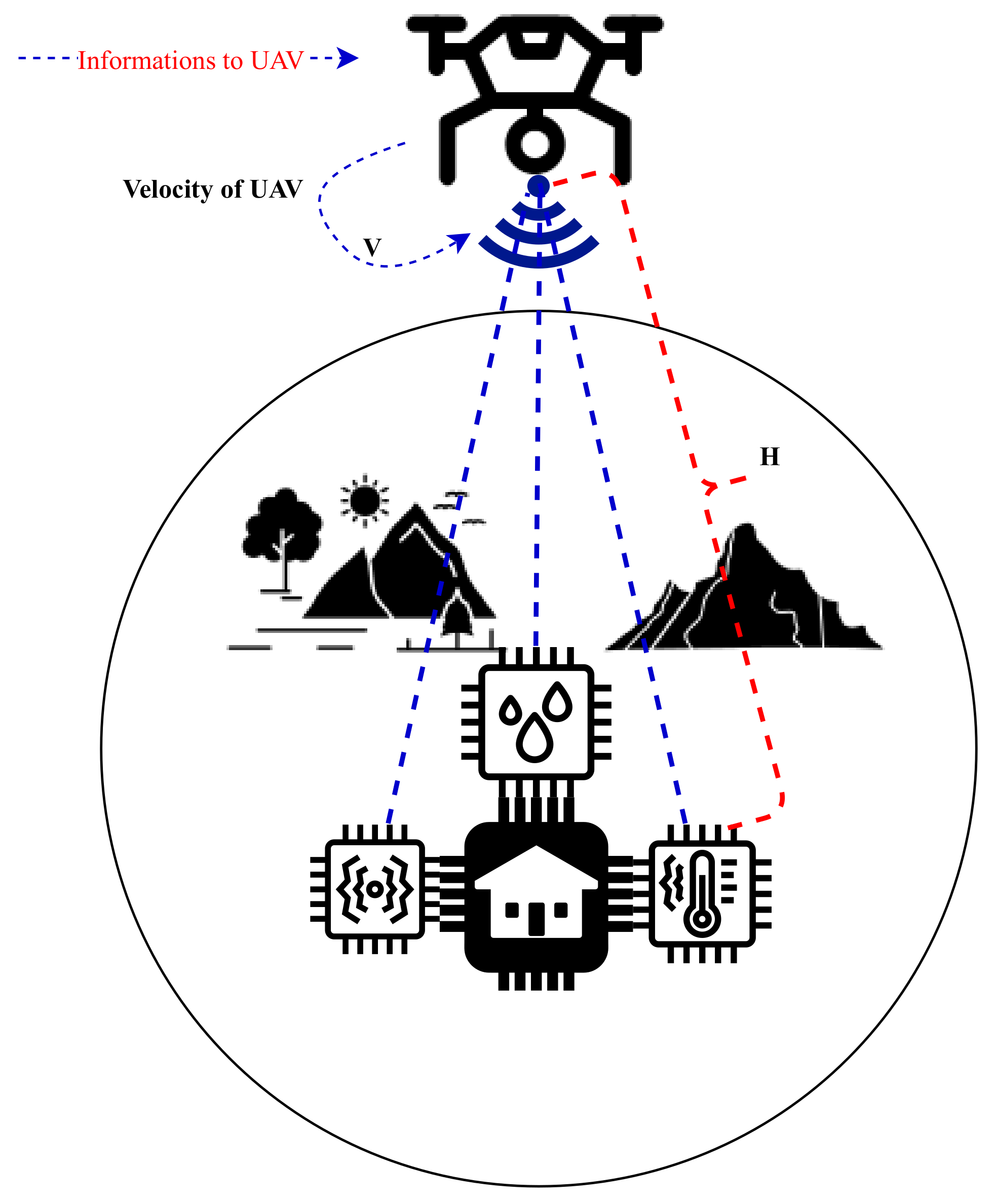
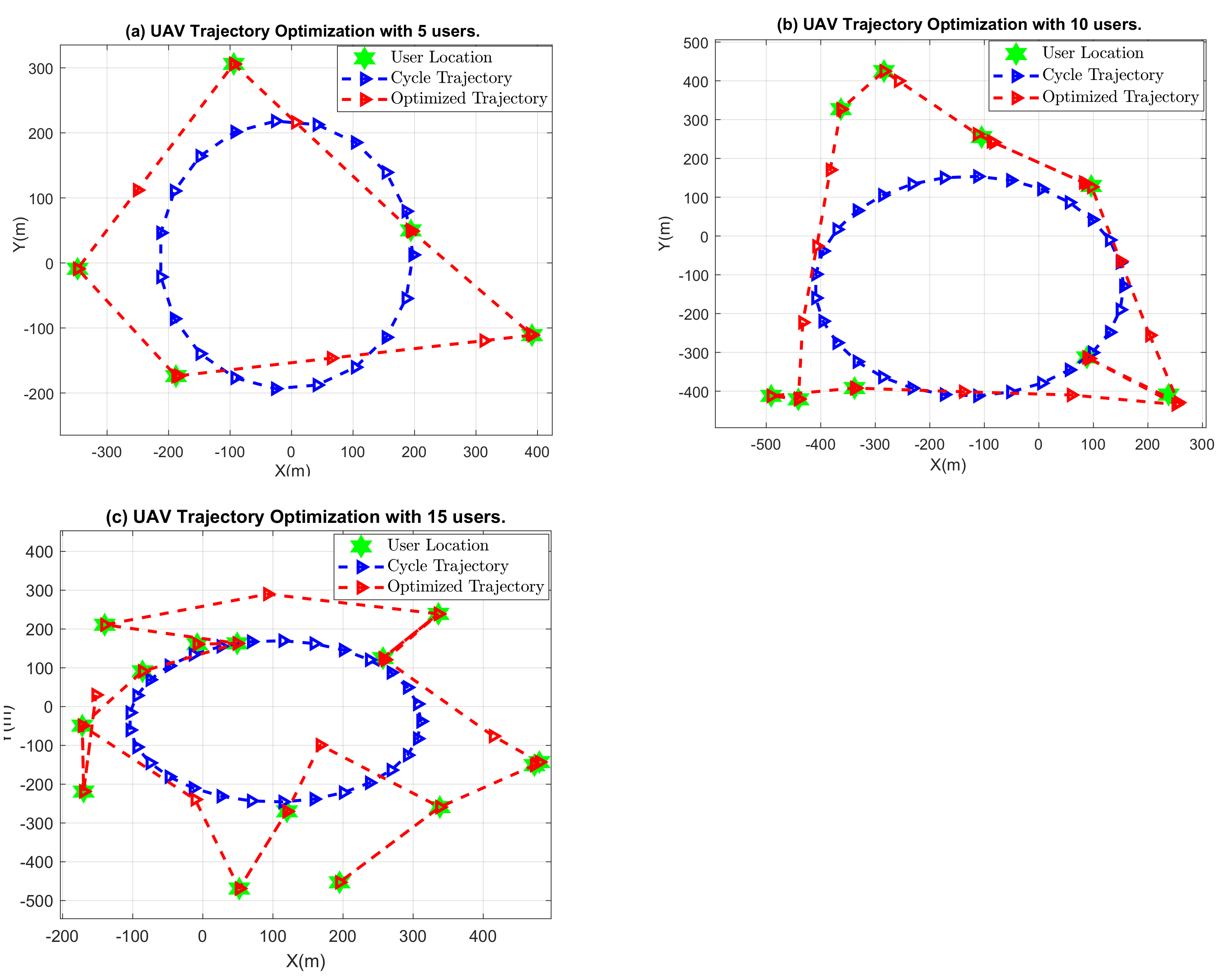
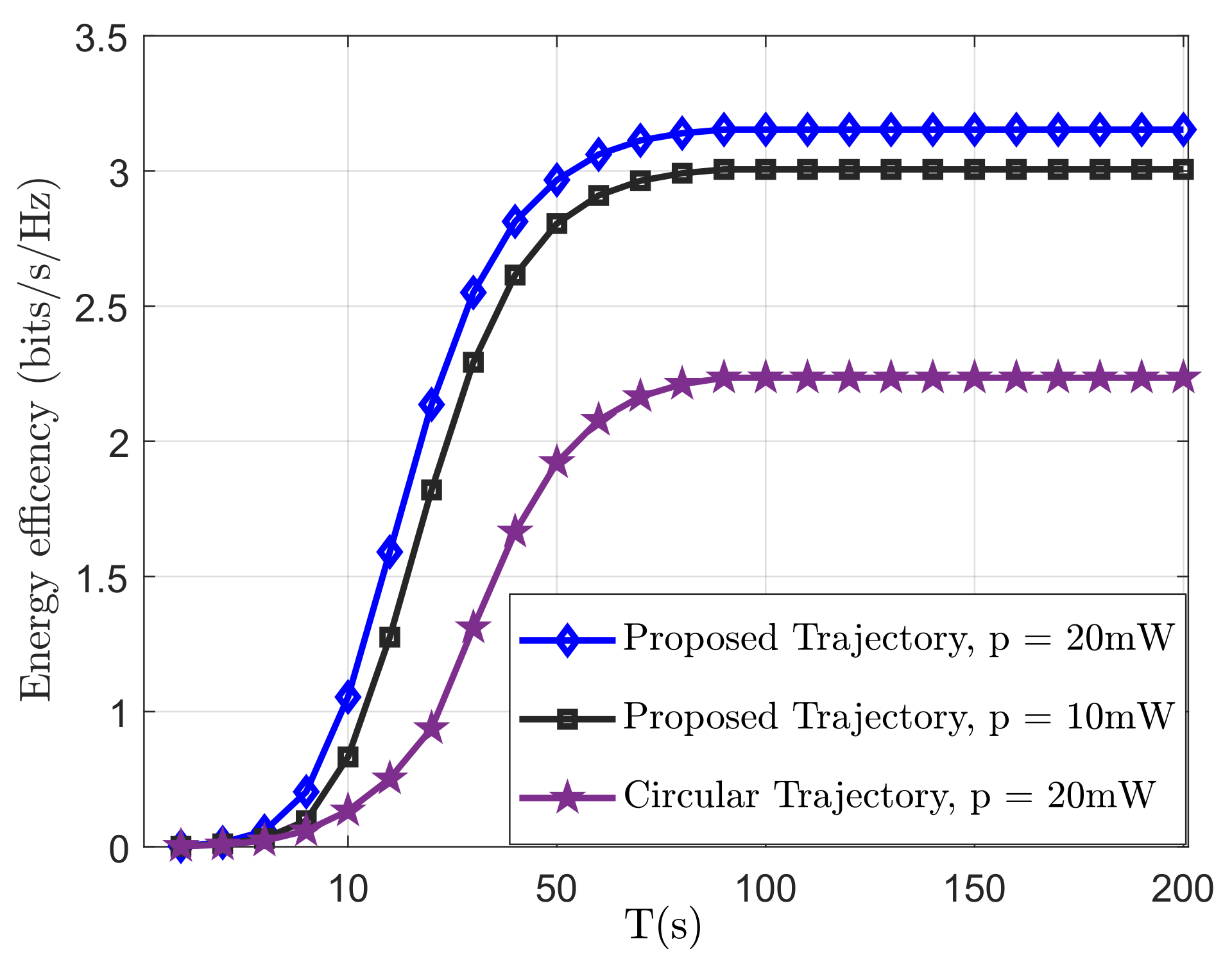
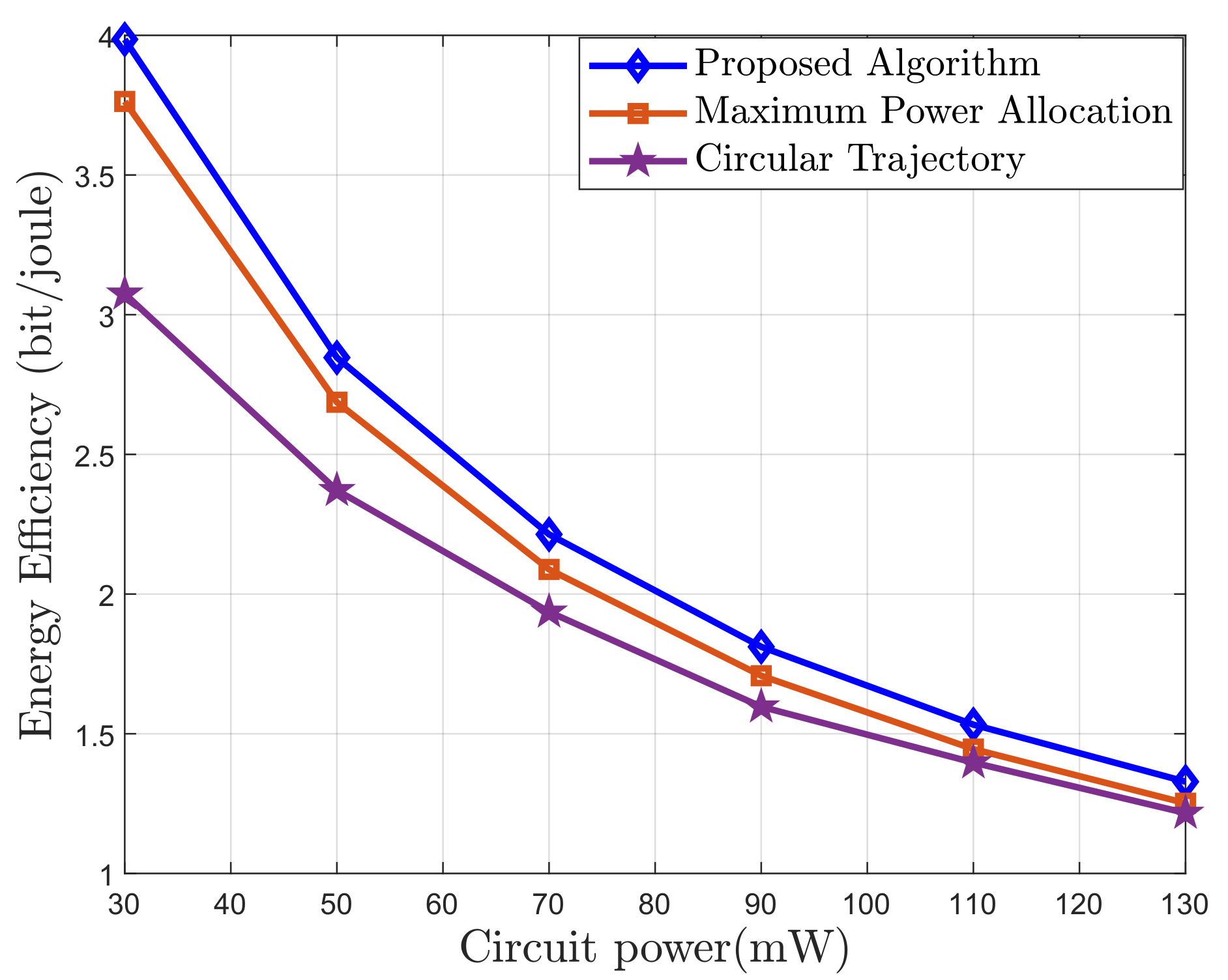

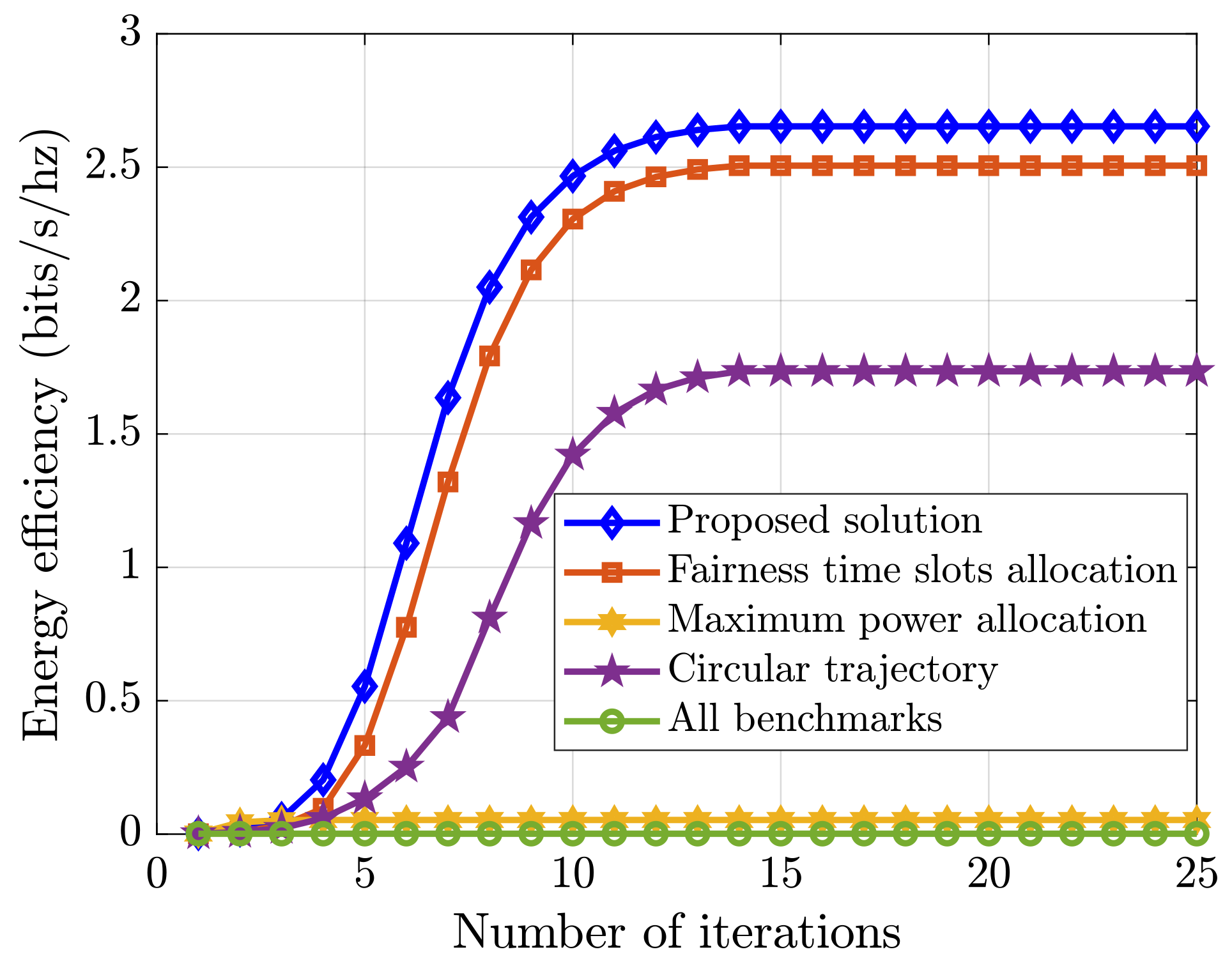
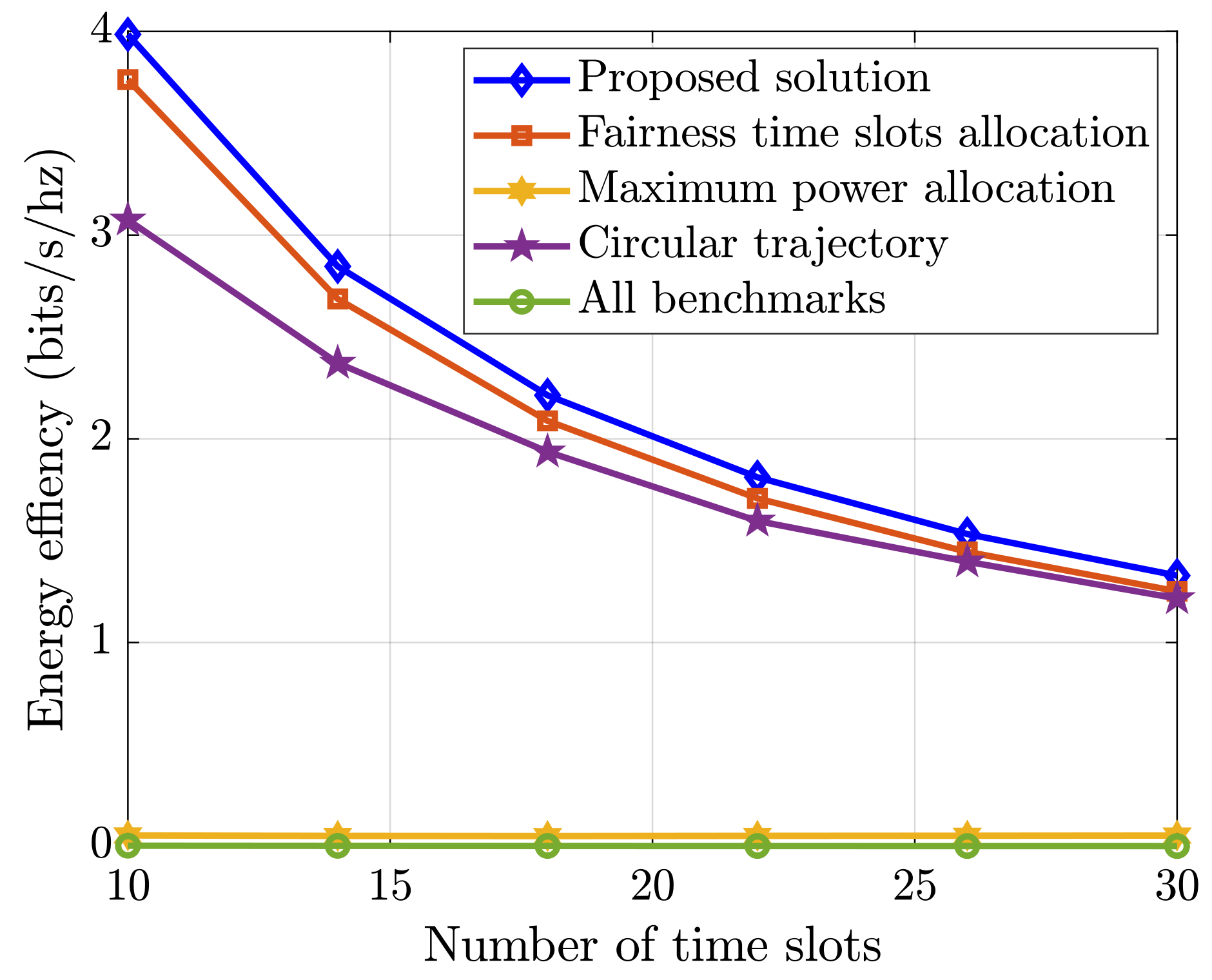

| Symbols | Descriptions |
|---|---|
| N | Number of users |
| L | Number of time slots |
| Allocated power at n user | |
| Transmitted signal from the n-th user | |
| Maximum transmit power of the n-th users | |
| Received signal at the UAV at the l-th time slot | |
| Additive white Gaussian noise at the l-th time slot with zero mean | |
| Integer variable | |
| Channel gain between the UAV and the n-th user in the l-th time slot | |
| Position of the UAV at the l-th time slot. | |
| Time slot assignment | |
| Power allocation | |
| Trajectory of UAV | |
| Reference channel power gain | |
| r | Cellular radius |
| Cycle duration | |
| H | Height of UAV |
| Maximum speed of UAV | |
| Power spectral density of the thermal noise | |
| Achievable rate of the n-th user using the l-th time slot | |
| Maximal EE | |
| B | Bandwidth |
| , | Terminated conditions |
| Parameters | Value |
|---|---|
| Cellular radius | 250 (m) |
| Cycle duration | 100 (s) |
| Reference channel power gain | |
| Height of UAV | 50 (m) |
| Maximum Speed of UAV | 50 (m/s) |
| Operating frequency | 1.9 (GHz) |
| Maximum transmit power of users | 23 (dBm) |
| Power spectral density of the thermal noise | −174 (dBm) |
| Bandwidth | 180 (kHz) |
| Terminated conditions | 0.0001 |
Publisher’s Note: MDPI stays neutral with regard to jurisdictional claims in published maps and institutional affiliations. |
© 2022 by the authors. Licensee MDPI, Basel, Switzerland. This article is an open access article distributed under the terms and conditions of the Creative Commons Attribution (CC BY) license (https://creativecommons.org/licenses/by/4.0/).
Share and Cite
Tung, T.V.; An, T.T.; Lee, B.M. Joint Resource and Trajectory Optimization for Energy Efficiency Maximization in UAV-Based Networks. Mathematics 2022, 10, 3840. https://doi.org/10.3390/math10203840
Tung TV, An TT, Lee BM. Joint Resource and Trajectory Optimization for Energy Efficiency Maximization in UAV-Based Networks. Mathematics. 2022; 10(20):3840. https://doi.org/10.3390/math10203840
Chicago/Turabian StyleTung, Tran Van, To Truong An, and Byung Moo Lee. 2022. "Joint Resource and Trajectory Optimization for Energy Efficiency Maximization in UAV-Based Networks" Mathematics 10, no. 20: 3840. https://doi.org/10.3390/math10203840
APA StyleTung, T. V., An, T. T., & Lee, B. M. (2022). Joint Resource and Trajectory Optimization for Energy Efficiency Maximization in UAV-Based Networks. Mathematics, 10(20), 3840. https://doi.org/10.3390/math10203840






